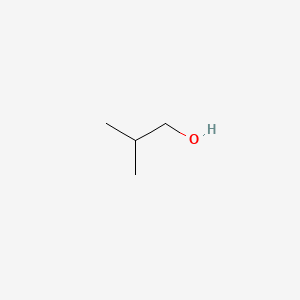|
|
|
|
pmid:19588922
|
| Varma MN and Madras G |
Effect of chain length of alcohol on the lipase-catalyzed esterification of propionic acid in supercritical carbon dioxide. |
2010 |
Appl. Biochem. Biotechnol. |
pmid:19575152
|
| Brynildsen MP and Liao JC |
An integrated network approach identifies the isobutanol response network of Escherichia coli. |
2009 |
Mol. Syst. Biol. |
pmid:19536200
|
|
|
|
|
pmid:19493534
|
| El-Sayed AM et al. |
Attraction and antennal response of the common wasp, Vespula vulgaris (L.), to selected synthetic chemicals in New Zealand beech forests. |
2009 |
Pest Manag. Sci. |
pmid:19479964
|
| Connor MR and Liao JC |
Microbial production of advanced transportation fuels in non-natural hosts. |
2009 |
Curr. Opin. Biotechnol. |
pmid:19473829
|
| French CE |
Synthetic biology and biomass conversion: a match made in heaven? |
2009 |
J R Soc Interface |
pmid:19454530
|
| Bruinsma M et al. |
Jasmonic acid-induced volatiles of Brassica oleracea attract parasitoids: effects of time and dose, and comparison with induction by herbivores. |
2009 |
J. Exp. Bot. |
pmid:19451186
|
|
|
|
|
pmid:19323737
|
|
|
|
|
pmid:19289243
|
|
|
|
|
pmid:19238469
|
| Bradley PH et al. |
Coordinated concentration changes of transcripts and metabolites in Saccharomyces cerevisiae. |
2009 |
PLoS Comput. Biol. |
pmid:19180179
|
|
|
|
|
pmid:19162148
|
| Pérez-Garrido A et al. |
Convenient QSAR model for predicting the complexation of structurally diverse compounds with beta-cyclodextrins. |
2009 |
Bioorg. Med. Chem. |
pmid:19056282
|
| Rossouw D et al. |
Linking gene regulation and the exo-metabolome: a comparative transcriptomics approach to identify genes that impact on the production of volatile aroma compounds in yeast. |
2008 |
BMC Genomics |
pmid:18990252
|
|
|
|
|
pmid:18970493
|
| Bhowal SK and Bhattacharyya M |
Determination of traces of molybdenum and tungsten by extraction and polarography of their salicoylhydroxamates. |
1989 |
Talanta |
pmid:18964849
|
|
|
|
|
pmid:18828580
|
| Davydov R et al. |
Characterization of the microsomal cytochrome P450 2B4 O2 activation intermediates by cryoreduction and electron paramagnetic resonance. |
2008 |
Biochemistry |
pmid:18700729
|
|
|
|
|
pmid:18585296
|
| Cheng L et al. |
Isolation and characterization of Methanoculleus receptaculi sp. nov. from Shengli oil field, China. |
2008 |
FEMS Microbiol. Lett. |
pmid:18557787
|
|
|
|
|
pmid:18541168
|
|
|
|
|
pmid:18449588
|
|
|
|
|
pmid:18371616
|
|
|
|
|
pmid:18329657
|
|
|
|
|
pmid:18295386
|
| Tollefson J |
Energy: not your father's biofuels. |
2008 |
Nature |
pmid:18288159
|
| Sampaio OM et al. |
Chemical profile of rums as a function of their origin. The use of chemometric techniques for their identification. |
2008 |
J. Agric. Food Chem. |
pmid:18275147
|
| Atsumi S et al. |
Non-fermentative pathways for synthesis of branched-chain higher alcohols as biofuels. |
2008 |
Nature |
pmid:18172501
|
| Schulz S et al. |
An antiaphrodisiac in Heliconius melpomene butterflies. |
2008 |
J. Chem. Ecol. |
pmid:18080165
|
| Chan WC and Lai YZ |
Kinetic characteristics of n-butyl alcohol and iso-butyl alcohol in a composite bead air biofilter. |
2008 |
Bioresour. Technol. |
pmid:17920881
|
|
|
|
|
pmid:17910788
|
| Basri M et al. |
Comparison of estimation capabilities of response surface methodology (RSM) with artificial neural network (ANN) in lipase-catalyzed synthesis of palm-based wax ester. |
2007 |
BMC Biotechnol. |
pmid:17760990
|
| Leisner JJ et al. |
Carnobacterium: positive and negative effects in the environment and in foods. |
2007 |
FEMS Microbiol. Rev. |
pmid:17696886
|
|
|
|
|
pmid:17681034
|
| Buelna G and Riffat R |
Preliminary environmental monitoring of water quality in the Rio Grande in the Laredo-Nuevo Laredo Region. |
2007 |
J Environ Sci Health A Tox Hazard Subst Environ Eng |
pmid:17680476
|
|
|
|
|
pmid:17646180
|
|
|
|
|
pmid:17629298
|
| Graybill ER et al. |
Functional comparison of citrate synthase isoforms from S. cerevisiae. |
2007 |
Arch. Biochem. Biophys. |
pmid:17570335
|
| Mercier J and Jiménez JI |
Potential of the volatile-producing fungus Muscodor albus for control of building molds. |
2007 |
Can. J. Microbiol. |
pmid:17538650
|
|
|
|
|
pmid:17511431
|
| DeMatos LL et al. |
Solvent influences on metastable polymorph lifetimes: real-time interconversions using energy dispersive X-ray diffractometry. |
2007 |
J Pharm Sci |
pmid:17455330
|
| Boumba VA et al. |
Biochemical pathways generating post-mortem volatile compounds co-detected during forensic ethanol analyses. |
2008 |
Forensic Sci. Int. |
pmid:17452087
|
| Arrizon J and Gschaedler A |
Effects of the addition of different nitrogen sources in the tequila fermentation process at high sugar concentration. |
2007 |
J. Appl. Microbiol. |
pmid:17381756
|
| Reeves MD et al. |
Effects of butanol isomers on dipalmitoylphosphatidylcholine bilayer membranes. |
2007 |
Biophys. Chem. |
pmid:17368700
|
|
|
|
|
pmid:17365033
|
| Yang HM et al. |
The role of the hydrophobic group on ring A of chalcones in the inhibition of interleukin-5. |
2006 |
Arch. Pharm. Res. |
pmid:17146965
|
|
|
|
|
pmid:17055030
|
| Balk M et al. |
Methanol utilizing Desulfotomaculum species utilizes hydrogen in a methanol-fed sulfate-reducing bioreactor. |
2007 |
Appl. Microbiol. Biotechnol. |
pmid:17028873
|
|
|
|
|
pmid:16972181
|
